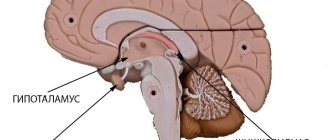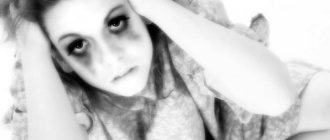- In the process of correcting the disease, attention is paid not only to stuttering, but also to the entire set of disorders. Such signs of neurosis-like logosyndrome include:
- fast fatiguability;
- motor disinhibition;
- exhaustion.
Accordingly, this directly reduces self-control and as a result causes speech deterioration, tachylalia, tongue-tiedness and neurosis-like stuttering.
It is interesting that the patients themselves do not suffer from their defect, and often do not even notice it.
They often verbally express their desire to get rid of stuttering. But this remains at the level of words. Therefore, forcing and motivating a child to follow these rules is the main task facing parents, speech therapists and educators. And the more they interact with each other, the more effective the treatment will be. Under no circumstances should you give up and lose hope - with great effort and perseverance, the result will definitely come. Patience and calm are the keys to success in treating such a condition as neurosis-like stuttering.
improvehealth.ru
Comparative characteristics of stuttering forms.
Characteristics of stutterers with a neurotic form.
The appearance of neurotic stuttering is usually preceded by psychogenia (fear or chronic mental trauma)
. The disease occurs acutely at 2-6 years of age.
Patients with this form have a history of no information indicating pathology of intrauterine development and childbirth. Psychophysical development and motor skills are usually normal. Early speech development is common
(the vocabulary is rapidly expanding, the grammatical structure of speech is formed early with the use of complex speech structures). The speed of speech is usually increased, the child seems to “choke” with speech, “swallows” the endings of words and sentences, and misses words and prepositions. A large number of interactions are often observed (Belyakova L.I.).
Before the onset of stuttering, such children experience increased impressionability, timidity, mood swings (usually in the downward direction), anxiety, touchiness, impatience, and tearfulness.
. Some children have fears (neurotic enuresis, fear of the dark, etc.). Such children find it difficult to get used to a new environment and do not tolerate kindergarten conditions well.
Stuttering often occurs acutely after suffering mental trauma against the background of good phrasal speech. Mutism is sometimes observed immediately
(the child stops speaking for a while, an expression of fear “freezes” on his face). With the onset of stuttering, children become even more irritable, restless, and have trouble sleeping. Sometimes whims are painful stubbornness. In addition to acute and chronic mental trauma, the neurotic form of stuttering often develops in children who are introduced to a second language in communication at the age of 1.5-2.5 years (Belyakova L.I.).
Neurotic form of stuttering
characterized by a recurrent course at the slightest emotional stress, fatigue, stuttering intensifies. This form of the disease has both favorable and unfavorable course. With a favorable course, the degree of stuttering is not severe, but it happens that the disease becomes chronic, in which remissions are not observed, and the speech disorder becomes more and more severe. Children with an unfavorable course already from 6-7 years of age suffer from a decrease in speech activity when communicating with new people or in a new environment; a situational dependence appears in the manifestation of the frequency and severity of convulsive stuttering.
In people who stutter with a neurotic form, their behavior changes dramatically by the age of 10-12 years. Children are aware of their defect, they are afraid of making a bad impression on their interlocutor, of not being able to express a thought, etc. At this age, persistent logophobia
(fear of verbal communication with an obsessive expectation of speech failures). A kind of vicious circle is formed - convulsive stuttering causes negative emotions, which, in turn, intensify stuttering. With age, logophobia becomes a priority, is obsessive in nature and occurs even when thinking about the need for verbal contact or when remembering unsuccessful past contacts (Seliverstov V.I.).
With an unfavorable course of the neurotic form of stuttering in adults, a feeling of social inferiority appears, a constantly reduced background mood, a situational fear of speech, which is often generalized, combined with a refusal of verbal communication in general
. The effectiveness of pedagogical influence on such people is low.
Characteristics of stutterers with a neurosis-like form.
As a rule, it appears gradually in children aged 3-4 years, without visible external causes. The history often includes severe toxicosis of pregnancy with symptoms of threatened miscarriage, asphyxia during childbirth
etc. For the first years of their lives, such children are restless, noisy, and sleep poorly.
Physical development is often delayed or at the lower limit of normal. They are distinguished by motor clumsiness, poor coordination of movements, and
behavior is characterized by excitability and disinhibition.
Children do not tolerate stuffiness, heat, or traveling in public transport. Children are often fussy, restless, and there is increased fatigue and exhaustion during intellectual work and physical activity. They have difficulty complying with disciplinary requirements and can be irritable and hot-tempered. Clinically, this condition is defined as cerebrasthenic syndrome
. The most striking differences from the norm are in speech development. Along with delayed speech development, there are disturbances in the pronunciation of many sounds, slow accumulation of vocabulary, and late and incomplete mastery of the grammatical structure of speech. The onset of stuttering coincides with the period of formation of phrasal speech, i.e. with the age of 3-4 years (Belyakova L.I.).
In the first period (1-6 months), stuttering occurs in waves, but periods without stuttering are usually not observed. In the absence of help, the disorder becomes more serious and quickly “overgrows” with abundant accompanying movements and embolophrasia (“wet” words, tricks). This form is characterized by monotony and stability of speech defect manifestations
, usually little dependent on external situational factors. Noteworthy is the pathology of motor functions, expressed to varying degrees: from a lack of coordination and mobility of the organs of speech articulation to a violation of the static and dynamic coordination of the arms and legs.
With this form of stuttering, movements are tense and disproportionate. There are disturbances in the coordination of movements of the arms and legs, fine motor skills of the hands, and articulatory motor skills. The most pronounced disorders are observed in facial, articulatory and fine motor skills of the hands, especially dynamic praxis. People who stutter have difficulty remembering the sequence of movements and have difficulty switching from one series of movements to another. Most of the stutterers in this group have difficulty reproducing and retaining a given tempo and rhythm in memory. As a rule, their ear for music does not develop well. Clinical examination usually reveals mild organic brain damage of a residual nature.
, and in addition to general cerebral syndromes (cerebrasthenic, hyperdynamic syndromes, etc.), they exhibit residual effects of damage to the motor systems of the brain (Kashchenko V.P.).
A speech therapy examination usually reveals a normal structure of the speech apparatus. All movements of the organs of articulation are characterized by some limitation
, there is insufficient mobility of the tongue and lips, poor coordination of articulatory movements, difficulty finding articulatory poses. There is often a violation of the muscle tone of the tongue, its “restlessness,” and undifferentiated tip. Quite often, in children with a neurosis-like form of stuttering, increased salivation is recorded not only during speech, but also at rest (Seliverstov V.I.).
of the prosodic aspect of speech also differs from the norm.
: the rate of speech is either accelerated or sharply slowed down, the voice is slightly modulated. As a rule, there is a sharp disturbance in speech breathing: words are pronounced during inhalation or at the moment of complete exhalation.
In the chronic course of a neurosis-like form of stuttering in adults, speech is often characterized by severe tonic-clonic convulsions in all parts of the speech apparatus. Speech is usually accompanied by various movements of the fingers, stamping, nodding movements of the head, swaying of the body and other friendly movements reminiscent of hyperkinesis, i.e. violent muscle contractions that are not of a masking or emotionally expressive nature. In severe stuttering, verbal communication becomes tiring for adults who stutter. Soon after the conversation begins, they begin to answer in monosyllables, complaining of a feeling of physical “fatigue to the point of exhaustion.” The mental state of adults is characterized by difficulty adapting to new conditions, decreased memory and attention, and exhaustion. For most of them, classes with a speech therapist bring relief in speech, in cases where correctional pedagogical work is regular and long-term.
.
In this article we tried to highlight two forms of stuttering, their features and differences. When working with the BreathMaker multimedia complex, we also distinguish between these two forms of stuttering.
With a neurotic form, it is difficult for the patient to maintain the desired pitch of the voice
, and with formant, as a rule, there are no problems.
In a neurosis-like form of stuttering, the pitch of the voice is usually well controlled, and the formant is achieved with a certain tension
.
Both forms can undoubtedly be treated with the help of the “BreathMaker” multimedia complex, only the approach to each form of stuttering, and of course to each patient, is individual.
- Belyakova L.I. , Dyakova E.A. Stuttering. Textbook for students of pedagogical institutes in the specialty “Speech Therapy” - M.: V. Sekachev, 1998. - 304 pp.: ill.
- Seliverstov V.I. “Stuttering in children, psychocorrectional and didactic foundations of speech therapy classes.” 3rd edition - Moscow 1994
- Kashchenko V.P. “Pedagogical correction.” Edition 2 - Moscow 1994
- "Stuttering." (edited by M.A. Vlasova, K.P. Becker - Moscow 1983)
- “Fundamentals of the theory and practice of speech therapy.” (edited by R.E. Levina - Moscow 1968)
- “Speech disorders in children and adolescents.” (edited by S.S. Lyapidevsky - Moscow 1969)
Author: Dr. Sinibor V.Yu.
Δ questions results our TV map blog e-mail
www.dictor.ru
Factors for improvement/deterioration of speech[ | ]
These factors vary depending on the type of stuttering, but there are some “rules” that “work” in most cases.
Conditions that favorably influence the speech of a stutterer[ | ]
I. A. Sikorsky in his monograph “On Stuttering” recommended “slow speech, pronounced in a low voice and monotonous tone” as a factor that reduces stuttering.
Mikryukova O.N. believes that singing and singing with movements is also useful for normalizing speech. It helps achieve smoothness and rhythm of speech. Singing helps develop the melody, strength and frequency of sounds. According to her, it is important to teach a child to breathe correctly. This contributes to the formation of a feeling of sound support.
Conditions that adversely affect the speech of a stutterer[ | ]
If stuttering is a neurosis, it intensifies when a person becomes nervous, as well as generally with strong emotions. It is also necessary to take into account the social environment - when alone, a person, as a rule, speaks without stuttering.
Children at risk who may stutter[ | ]
| This section is missing references to information sources. Information must be verifiable, otherwise it may be questioned and deleted. You may edit this article to include links to authoritative sources. This mark was set on May 4, 2020 . |
- children who suffered from spasmophilia
. Such children have increased seizure activity; - children with anxious character traits or observing conflict situations in the family;
- children with speech development delay ( SRD
),
alalia
or
dysarthria
aged 3-6 years; - children with early accelerated speech development, when demands are made that are beyond the child’s strength and information overload occurs;
- children who are surrounded by people who stutter;
- children with bilingualism: early learning of two or more languages provokes a decrease in the adaptive capabilities of the central nervous system;
- socially deprived children.
What is neurosis-like logosyndrome?
This is a genetic underdevelopment of speech or its destructive disorder, which appears as a result of a concussion, its inflammation, head injuries and other destructive factors. The main features common to all victims of neurosis-like logosyndrome are the following:
- tachylalia – accelerated rate of speech;
- dyslalia – tongue-tiedness;
- neurosis-like stuttering.
It is noteworthy that the more a person controls his speech, the more clearly he pronounces sounds and the slower he speaks, the less stuttering appears. With a decrease in self-control and an increase in tempo, stuttering immediately makes itself felt. It is necessary to remind the child in every possible way to monitor his speech and be demanding about the clear pronunciation of words. Only then will the stuttering stop.
Characteristics of neurosis-like stuttering
In this case, stuttering first appears at 2.5–3 years of age. The source of the speech disorder lies in a psychogenic event (fear). Stuttering has a wave-like character, but complete remissions are not observed. Over time, it reaches its climax and even causes tonic articulatory, respiratory and clonic convulsions, which directly affect the onset of speech. Some patients resort to additional words and sounds, and gestures during conversations. Severe tongue-tiedness and a fast pace of speech make what is said difficult to understand for others, and is often associated with the infantile speech of two-year-old children.
Features of neurotic stuttering
Stuttering occurs as a result of psychogenic behavior, which can be in the form of fear or in the form of a change of environment (for example, when going to kindergarten for the first time). The average age of onset of the defect is 2.5-3 years, when phrasal speech has already been formed. Speech disorder manifests itself in the form of clonic and tonic convulsions. It happens that stuttering is accompanied by impaired breathing, or more precisely in the form of a shortened exhalation. It proceeds in waves, sometimes it goes away unexpectedly, but in a small exciting situation it appears again. This in turn increases neurotic symptoms in children. Nowadays, there are many different techniques that are designed to normalize breathing, muscle tone, rhythm of speech and the patient’s psyche.
True, statistics claim that only a few who turn to a speech therapist, psychologist or physician are cured of stuttering (25-30%). Many (40%) can boast of some improvement in speech.
But in the slightest stressful situation, during mental or physical stress, it is completely leveled out. Moreover, there is a chronic fear that the disease will never go away. In addition, incorrectly selected treatment only aggravates the situation, increasing self-doubt and fear of communication with other people.
Treatment for stuttering
Treatment of logoneurosis occurs under the auspices of doctors who have knowledge of psychotherapy, and treatment of neurosis-like stuttering requires the presence of a speech therapist and educator. In the first case, it is forbidden to draw the patient’s attention to his speech defect, and in the second, everything is completely opposite.
Accordingly, this directly reduces self-control and as a result causes speech deterioration, tachylalia, tongue-tiedness and neurosis-like stuttering.
It is interesting that the patients themselves do not suffer from their defect, and often do not even notice it.
They often verbally express their desire to get rid of stuttering. But this remains at the level of words. Therefore, forcing and motivating a child to follow these rules is the main task facing parents, speech therapists and educators. And the more they interact with each other, the more effective the treatment will be. Under no circumstances should you give up and lose hope - with great effort and perseverance, the result will definitely come. Patience and calm are the keys to success in treating such a condition as neurosis-like stuttering.
improvehealth.ru
Treatment methods[ | ]
Treatment of stuttering in any case has a direct or indirect effect on speech function, leading to an improvement in the condition as a result of the body’s compensatory reaction to one or another type of corrective action. Due to the fact that stuttering has pronounced functional, personal and social aspects, its treatment necessarily contains therapeutic, pedagogical and rehabilitation components. At the same time, the significance and effectiveness of the pedagogical and rehabilitation components depend on the patient’s individual abilities to perceive correction. Therefore, treatment of stuttering is a complex and controversial process, which does not always depend on the quality of the method used.
There are a number of ways to cure stuttering, but, unfortunately, none of them is 100% guaranteed. All methods [ source not specified 3941 days
] are one way or another divided into those who consider stuttering as a speech defect and as a logoneurosis.
All stuttering treatment methods are divided into types of methodological approach and types of therapeutic influence. In general they can be divided into:
- Speech therapy
- Psychological
- Psychotherapeutic
- Logopsychotherapeutic
- Socio-rehabilitation
- Medication
- Physiotherapeutic
- Complex
- Non-traditional.
The therapeutic organization of stuttering treatment methods can be: outpatient, inpatient, family, group and individual.
Some authors of stuttering correction systems: Nekrasova Yu. B., Dubrovsky K. M., Gromyko V. M..
What is neurosis-like or organic stuttering?
Did you like the post? Share:
Hello! As for the treatment prescribed for your daughter, I’m not a doctor. I am a mother just like you. But I was very alarmed that the same Afobazole is contraindicated for children under 18 years of age.
You were prescribed Phenibut, we took Noobut. In principle, both of them are nootropics. We were prescribed glycine in parallel with Noobut, and when we started sleeping poorly, we were prescribed Nott. So, in my opinion, adjustments to your daughter’s treatment are simply necessary. Go to your neurologist and tell him about the side effects of the treatment he prescribed that you observe in your daughter.
Do not forget, also, that you can get a consultation from another neurologist. We took all the research results and even addressed several. Consult a psychiatrist as well. As for drug treatment, it seems to me that a psychiatrist is more competent in this matter.
We have a day hospital in Dnepropetrovsk. We went there for a month. In addition to drug treatment, our son received massage of the collar area, physiotherapeutic procedures (electrophoresis, electrosleep), we worked with a speech therapist and were under the constant supervision of doctors - both a neurologist and a psychiatrist. Maybe there is something like this in your city. Ask at your clinic. A psychiatrist sent us there.
There are also special sanatoriums for children with speech disorders. One of them, again, is here, in Dnepropetrovsk. This is where it would be nice for you and your daughter to go. Calm environment. Every day - classes with a speech therapist, communication classes, physical therapy. Find out, maybe you have this too. If not, contact your city (district, regional) speech therapist. He will definitely help you.
And in no case underestimate the importance of breathing exercises and exercises to strengthen the muscles of the articulatory apparatus. Exercise regularly, the results will be - as they say, tested on yourself. My son and I also downloaded the cartoon concert from YouTube and often sing together. Both fun and useful.
Your task is to collaborate with three specialists at once - a neurologist, a psychiatrist and a speech therapist. It wouldn't hurt to involve a psychologist. Of course, you will have to fight. We did not stop stuttering completely, but it became much easier for my son to communicate with others. I'm sure everything will work out for you. Contact me as much as I can, I will help.
www.detsko.com
Non-drug methods
There are many methods for correcting stuttering, but all of them are designed to eliminate a specific root cause, so sessions with a speech therapist should take place individually under the consultation of a psychotherapist. A psychologist is also necessary in this situation, because the child’s fragile psyche perceives his speech feature as something shameful, which leads to withdrawal and reluctance to communicate with peers. Sometimes group therapy produces positive results when the child communicates with children who have the same speech disorder. This helps the child accept himself and, in some cases, the stuttering goes away on its own. Hypnosis treatment is also practiced, which is directly related to eliminating the cause that led to stuttering. And the most basic and important task lies on the shoulders of the parents, because it will depend on them how the child will behave in a given stressful situation. Therefore, by regularly devoting time to your child, you can prevent the development of logoneurosis in him in the future.
opsihoze.ru
Neurosis-like stuttering: period of occurrence, diagnosis and treatment
Stuttering, or logoclonia, is a tempo-rhythmic speech disorder that is manifested by prolongation, pauses and interruptions of sounds, syllables and words. The presented disorder has been encountered since the moment people learned to speak. The prevalence of stuttering in adults is 1%. Among children, this figure is higher and equal to 3-4%. In addition, statistics show that boys are 4 times more likely to suffer from logoclonia. Many people think that the only cause of this pathology is a severe nervous shock, for example, fear. There is a neurosis-like form of stuttering that appears against the background of organic pathology of the nervous system.
Content:
Stuttering, its types and pathogenesis
Stuttering is a speech defect that disrupts rhythm and slows down the tempo of spoken sounds. Symptoms of logoclonia (interruption, pauses, prolongation) are observed in 80% of cases at the beginning of a sentence and in 20% in the middle. The mechanism of stuttering consists of increased convulsive readiness of the organs of articulation. These include the muscular component of the pharynx, soft palate, epiglottis, tongue, and vocal cords. When trying to pronounce a sound, an involuntary contraction of the represented structures occurs, which is why the person begins to stutter.
Based on the presented mechanism, logoclony is divided into three forms:
In addition to the presented classification of forms, a distinction is made between neurotic and neurosis-like stuttering. The first option is otherwise called logoneurosis, the occurrence of which is not associated with structural or physiological pathology, but is of a functional (psychogenic) nature. Neurosis-like stuttering is the result of an organic pathology of the nervous system.
The pathogenesis of logoclonus includes a disruption of three processes: breathing, articulation and vocalization, which are controlled by the striopalidary system. In this regard, a disorder occurs in the processes of inhibition and excitation in the cerebral cortex. Thus, there is a violation of the rational redistribution of muscle tone of the speech apparatus. In a person who has been stuttering for a long time, increased speech tone, together with convulsive readiness, develops into a conditioned reflex.
Critical periods
Critical speech periods play an important role in the occurrence of stuttering. The presented periods are not an etiological factor, but only provoke verbal disorders. During critical periods, the body undergoes systemic restructuring and is more susceptible to speech disorders.
There are three critical periods in the development of speech function.
The presented critical periods are contributing factors in the development of speech pathology and in some cases can be combined with other provoking agents. These include: genetic predisposition, encephalopathic diseases, exhaustion of the nervous system, emotional detachment.
Speech development and the course of critical periods are individual and depend on many factors, namely genetics, ecology and environment.
Etiology of neurosis-like stuttering
In the neurosis-like form of stuttering, in contrast to the neurotic form, there is no connection with the psychological factor. The basis for the development of the presented stuttering is organic pathologies of the nervous system. The most common causes of neurotic stuttering include:
Knowing the causes of neurosis-like stuttering allows the doctor to correctly determine the doctor’s further tactics and prescribe appropriate therapy.
Symptoms and methods for diagnosing stuttering
Stuttering in a neurosis-like form manifests itself in a classic clinical picture with prolongation, pauses and other tempo-rhythmic delays in speech. With this type of logoclonus, neurological symptoms may be observed. Children with a neurosis-like form of stuttering begin to speak later than others and have problems with coordination. When examined, the articulatory apparatus is constrained and movements in it are difficult. Also a manifestation of the neurosis-like form is the occurrence of generalized convulsions at the time of stuttering. A distinctive characteristic of neurosis-like stuttering from other types is the persistence of symptoms that do not depend on external circumstances.
The presence of the described symptoms, although characteristic of neurosis-like stuttering, is not sufficient to make this diagnosis. To obtain objective information, instrumental research methods are used. The presence of organic pathology is determined using electroencephalography (EEG), magnetic resonance imaging (MRI), computed tomography (CT) and duplex examination of cerebral vessels.
The first method, based on measuring biopotentials, is capable of accurately determining any changes in the structure of the cortex and other parts of the brain. Magnetic resonance imaging allows you to evaluate the state of the entire nervous system through horizontal sections and three-dimensional images. The presented method has high sensitivity in determining oncological pathology.
Computed tomography, like duplex scanning, is the best method for assessing the vascular system of the brain. In addition, CT can detect injuries, old hematomas, abscesses and other structural pathologies of the brain.
Important! The appearance of symptoms of stuttering without previous mental trauma may serve as the first signal of a disruption in the functioning of the nervous system. In this case, timely diagnosis will allow you to prescribe effective treatment and restore speech function
Differential diagnosis and treatment of neurosis-like stuttering
Neurosis-like stuttering and logoneurosis have a similar clinical picture, so it is appropriate to conduct a differential diagnosis of these two diseases.
simpletomyinfo.ru
How speech is formed
The pathogenesis of stuttering has its own characteristics, since speech function is controlled by two brain centers - Wernicke and Broca. They are located in the temporal and frontal lobes, respectively.
The first is responsible for posing sentences and analyzing speech received from outside. In other words, it represents the auditory center of the brain. But Broca's area is responsible for voice production through a direct effect on the facial muscles that are responsible for speech production. With pathology, there is a partial loss of functions of one or another area of the brain, which leads to unequal speed of their work, and stuttering occurs. Normally, these brain centers act together, which has a positive effect on speech as a whole.
The severity of stuttering will depend on the nature and severity of damage to the above-mentioned Wernicke and Broca's areas.
Symptoms and features
With a neurosis-like speech disorder, the child speaks very quickly and a lot, and can actively gesticulate. It is characteristic that with this type of speech disorder there is no logophobia and criticism of his condition; the patient does not realize that he speaks differently from others and does not seek to hide his deficiency.
Usually the disease is accompanied by underdevelopment of the psyche and motor skills, and insufficiency in the sphere of emotions. Symptoms intensify with mental excitement, after physical activity and as a result of previous colds and other somatic diseases. For example, after suffering from cystitis, gastritis, glomerulonephritis, viral colds, influenza, sore throat, chicken pox, influenza, etc.
Typically, organic stuttering is weakly expressed at first, and intensifies over time, along with the acquisition of more and more new words and the appearance of phrases in speech. The spasms are concentrated in the lips, soft palate and tongue. The most difficult sounds for a child to learn are consonants. But despite this, the number of words spoken and the speed of speech are higher than usual.
Children with dysarthria (impaired innervation of the speech apparatus) and dyslalia (impaired pronunciation of certain sounds) speak inexpressively, pronouncing sounds muffled and monotonous. They compensate for insufficiently expressive speech with gestures or exaggerated facial expressions, similar to grimacing.
Most often, organic stuttering manifests itself during the period of active speech development - at 3-4 years.
The diagnosis of “neurosis-like stuttering” is made by a speech therapist, neurologist and psychologist. A neurology specialist can write a diagnosis of “organic stuttering” on the patient’s chart. These same doctors prescribe a range of treatments – from working with a speech therapist to psychotherapy. But the main method of correcting the disease is the treatment of brain disorders.
If adequate treatment was not provided in childhood, neurotic symptoms associated with awareness of problematic speech may develop in adolescence. The teenager experiences difficulties communicating and positioning himself in a peer group, and begins to fixate on complex sounds, which causes logophobia, sweating and panic when having to speak in public. Stuttering intensifies in a new environment, while communicating with new people. In this case, we are talking about mixed stuttering - neurotic with a neurotic component.
Etiology
Stuttering is caused by disorders of higher nervous activity that regulate the functions of speech mechanisms. Stuttering is a symptom of diseases of various origins with characteristic disorders and clinical manifestations. It always coexists with other neuropsychiatric disorders. Stuttering can occur due to mental trauma (single-stage or long-term) and infectious diseases.
Typically, stuttering develops during a period of intensive speech development, most often at the age of 3-5 years, when the child begins to speak in phrases, more often in boys. Relapses are possible during critical periods of development (6-7 years and maturation).
Associated manifestations
Children have many other symptoms, for example, they find it difficult to do things as quickly and dexterously as their peers, so they may drop things more often, fall out of the blue, dress sloppily, and take a painfully long time to tie their shoelaces.
In general, movements are constrained and monotonous, fine motor skills are not sufficiently expressed. Signs of dyslexia (difficulty learning to read), dysgraphia (problems with writing), and synkinesia (involuntary muscle contractions) may be observed.
Changes are noticeable even in character and behavior - the child may be generally slow, “difficult to climb,” and impulsive. He quickly gets excited, but quickly gets tired and begins to get irritated. The sense of rhythm is poorly developed, the coordination of movements is impaired. When delving into the medical history, it usually turns out that the child developed more slowly than his peers in the first two years of his life.
The organic form of stuttering is characterized by the persistence of speech impairments - the child experiences the same difficulties with pronunciation both at home, in a quiet environment, and among new people, in an unfamiliar place. Symptoms intensify only due to the need to talk a lot and general excitement.
Organic stuttering is caused by parental illness - schizophrenia, bipolar disorder, syphilis, tuberculosis. A common reason is smoking and drug use by the mother, as well as working in hazardous work and taking medications prohibited during pregnancy.
But the disease can also occur in a child of prosperous, healthy parents - as a result of severe late toxicosis, intrauterine infections and hypoxia, intracranial trauma and asphyxia during childbirth, and other complications of pregnancy and childbirth.
An important role in the occurrence of speech disorders is played by the factor of genetic predisposition - if one of the parents or grandparents stutters, the child has a chance to “inherit” their defect.











